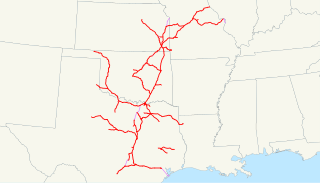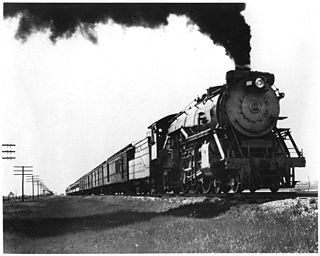Gallery
- Chicago, Burlington and Quincy Railroad coach Silver Falls
- MKT troop sleeper No. 100261
Prior to closure, [1] the Wichita Falls Railroad Museum was a railroad museum in Wichita Falls, Texas. It was founded in 1980 to establish a museum of railroad, streetcar, and pioneer history. [2] Starting its existence in the town's historic Depot Square, it changed locations over time, but had since 1992 been located back in Depot Square. [2]
Rolling stock included the Fort Worth and Denver Railway No. 304 steam locomotive, [2] and the Missouri–Kansas–Texas Railroad ("Katy") diesel switcher 1029, [2] as well as Commuter Cars, Pullman Troop Sleepers, Dining Cars, Post Office and Baggage Cars, Cabooses and more. [3]
The museum closed in March 2020 because of the COVID-19 pandemic. [1] Museum officials originally agreed with the City of Wichita Falls, which owned the museum building, to terminate the lease and, by the end of 2021, ship the contents to the Museum of North Texas History, also in Wichita Falls. [1] However, by May of 2022, no final plan regarding what to do with the artifacts had been approved by the City of Wichita Falls, and the artifacts remained behind locked gates in their old location. [4]

Henrietta is a city in and the county seat of Clay County, Texas, United States. It is part of the Wichita Falls metropolitan statistical area. The population was 3,141 at the 2010 census, a decline of 123 from the 2000 tabulation of 3,264.

Gainesville is a city in and the county seat of Cooke County, Texas, United States. Its population was 16,002 at the 2010 census. It is part of the Texoma region and is an important Agri-business center.

Wichita Falls is a city in and the seat of government of Wichita County, Texas, United States. It is the principal city of the Wichita Falls Metropolitan Statistical Area, which encompasses all of Archer, Clay, and Wichita counties. According to the 2010 census, it had a population of 104,553, making it the 38th-most populous city in Texas. In addition, its central business district is 5 miles (8 km) from Sheppard Air Force Base, which is home to the Air Force's largest technical training wing and the Euro-NATO Joint Jet Pilot Training program, the world's only multinationally staffed and managed flying training program chartered to produce combat pilots for both USAF and NATO.

U.S. Route 287 (US 287) is a north–south United States highway. At 1,791 miles (2,882 km) long, it is the second longest three-digit U.S. Route, behind US 281. It serves as the major truck route between Fort Worth and Amarillo, Texas, and between Fort Collins, Colorado, and Laramie, Wyoming. The highway is broken into two segments by Yellowstone National Park, where an unnumbered park road serves as a connector.

The Missouri–Kansas–Texas Railway was a Class I railroad company in the United States, with its last headquarters in Dallas, Texas. Established in 1865 under the name Union Pacific Railway, Southern Branch, it came to serve an extensive rail network in Texas, Oklahoma, Kansas, and Missouri. In 1988, it merged with the Missouri Pacific Railroad; today, it is part of Union Pacific Railroad.

In United States railroad terminology, a troop sleeper was a railroad passenger car which had been constructed to serve as something of a mobile barracks for transporting troops over distances sufficient to require overnight accommodations. This method allowed part of the trip to be made overnight, reducing the amount of transit time required and increasing travel efficiency.

The St. Louis–San Francisco Railway, commonly known as the "Frisco", was a railroad that operated in the Midwest and South Central United States from 1876 to April 17, 1980. At the end of 1970, it operated 4,547 miles (7,318 km) of road on 6,574 miles (10,580 km) of track, not including subsidiaries Quanah, Acme and Pacific Railway and the Alabama, Tennessee and Northern Railroad; that year, it reported 12,795 million ton-miles of revenue freight and no passengers. It was purchased and absorbed into the Burlington Northern Railroad in 1980. Despite its name, it never came close to San Francisco.

The Denver Zephyr was a streamlined passenger train operated by the Chicago, Burlington and Quincy Railroad between Chicago, Illinois, and Denver, Colorado. In peak years it ran to Colorado Springs. It operated from 1936 to 1973. The Denver Zephyr continued operating after the Burlington Northern Railroad merger in 1970. BN conveyed the train to Amtrak in 1971; Amtrak merged it with the Denver–Oakland City of San Francisco to form the San Francisco Zephyr and dropped the "Denver" name in 1973.

The Fort Worth and Denver Railway, nicknamed "the Denver Road", was a class I American railroad company that operated in the northern part of Texas from 1881 to 1982, and had a profound influence on the early settlement and economic development of the region.
The Oklahoma, Kansas and Texas Railroad (OKT) was a railroad operating in its namesake states in the 1980s.
The Gainesville, Henrietta and Western Railway Company (GH&W) was chartered on July 23, 1886, to build a rail line from Gainesville in Cooke County, Texas, to Seymour in Baylor County, Texas, a distance of 130 miles (210 km). The line was to cross Montague, Clay, and Wichita Counties.

The Texas Special was a named passenger train operated jointly by the Missouri–Kansas–Texas Railroad and the St. Louis–San Francisco Railway. It was the flagship of both these lines, operating between St. Louis, Missouri, and San Antonio, Texas, from 1915 until 1959, after which time the Katy changed the northern destination from St Louis to Kansas City after the Frisco discontinued service from St. Louis.

The Texas Zephyr was a named passenger train operated by the Colorado & Southern Railway and the Fort Worth & Denver Railway. The train was originally designated number 1 southbound, and number 2 northbound.
The Twin Star Rocket was a passenger train operated by the Chicago, Rock Island and Pacific Railroad. Introduced on January 14, 1945, it was the only new streamlined train permitted to enter service in World War II by the U.S. government. The new train became the second longest north–south train itinerary under the management of a single railroad in the United States with its northern terminal at the Milwaukee Road’s Minneapolis depot and southern terminal 1,363 miles (2,194 km) away at Houston, Texas. The name of the new streamlined train was derived from its terminal states—Texas being known as the Lone Star State and Minnesota as the North Star State. Additionally, the name references Minneapolis being one of the Twin Cities and Houston's aerospace industry and culture.
Article X of the Texas Constitution of 1876 covers railroad companies and the creation of the Railroad Commission of Texas. The federal government later created the Interstate Commerce Commission to regulate railroads, and eight of the nine sections of Article X were repealed in 1969 as "deadwood".
The Museum of North Texas History in Wichita Falls, Texas depicts the history of the area with exhibits, pictures, clothing and artifacts, striving to show the rich heritage of north Texas and how it is relevant today. Permanent exhibits include the Bill English Military Collection, the Heritage Hall which is home to an amazing collection of western hats known as "Nat's Hats," old Medical equipment, the Mary Thomas Doll & Toy Collection, and, at the Wichita Falls Regional Airport, the Jenny to Jets Exhibit which runs from an old Jenny biplane to a modern T-38 jet trainer of Sheppard Air Force Base.

Fort Worth and Denver City Railway 410 / Texas and Pacific Railway 400 is a class "E-4A1" 2-8-2 "Mikado" that was originally operated by the Fort Worth and Denver City Railway (FW&DC). It served the FW&D from 1915 to 1958 before being sold to the T&P on January 29, 1958. It was briefly used for Flood Service in Louisiana before being retired and donated to Marshall, Texas in 1963. Today, the locomotive is on display at the Texas and Pacific Railway Museum in Marshall, Texas.
The Wichita Falls and Oklahoma Railway, together with its affiliate the Wichita Falls and Oklahoma Railroad of Oklahoma, built a line from Wichita Falls, Texas to Waurika, Oklahoma in two stages, starting in 1903 and completing in 1923. Results were disappointing, and the line was abandoned in late 1942.
Coordinates: 33°54′46″N98°29′18″W / 33.9129°N 98.4882°W